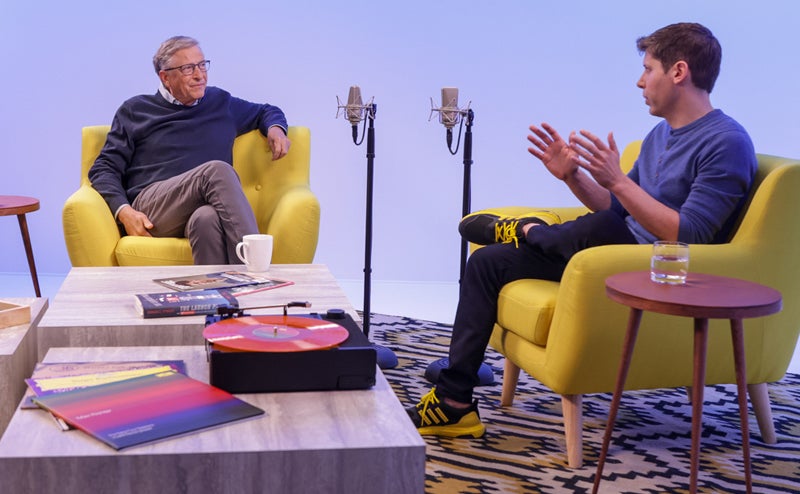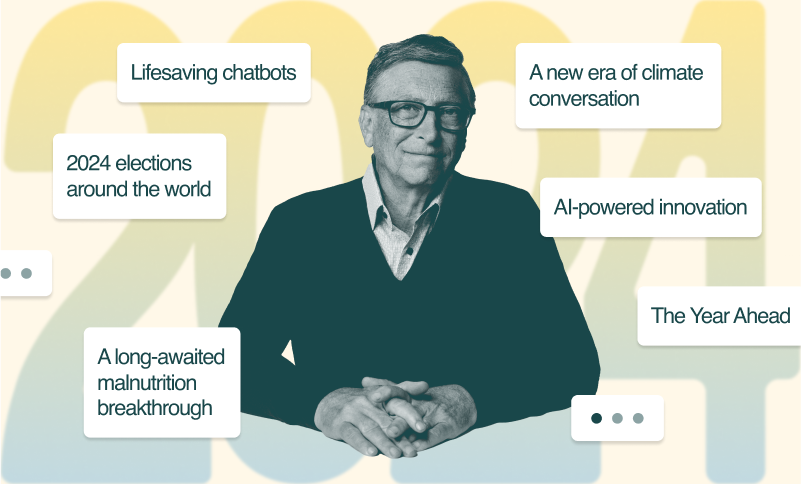I can’t think of another time when a national leader has broached such a sensitive topic so frankly and so publicly.
I turned 67 in October. It’s hard to believe I’m that old—in America, most people my age are retired!
But I won’t be slowing down anytime soon. I’m still going full speed on the project I began more than two decades ago, which is to give the vast majority of my resources back to society. Although I don’t care where I rank on the list of the world’s richest people, I do know that as I succeed in giving, I will drop down and eventually off the list altogether.
I’ve always viewed my philanthropy as a way to help reduce the awful inequities I see around the world. I also feel a responsibility to give my wealth back to society in ways that do the most good for the most people. But I started looking at the world through a new lens recently—when my older daughter gave me the incredible news that I’ll become a grandfather next year.
Simply typing that phrase, “I’ll become a grandfather next year,” makes me emotional. And the thought gives a new dimension to my work. When I think about the world my grandchild will be born into, I’m more inspired than ever to help everyone’s children and grandchildren have a chance to survive and thrive.
This is a long-term project that requires patience; in the effort to make the world more equitable, success is measured in years and decades. Maybe age makes it easier to understand this. When I was in my twenties, I didn’t think that anyone my grandparents’ age had anything useful to offer the world at large. As I get older, though, I see how wrong I was.
I do almost all of my work through the Gates Foundation, though most of my efforts on climate and clean energy are housed at Breakthrough Energy and I fund research on Alzheimer’s disease separately. Global health is a major focus for the foundation because it’s the worst inequity on the planet and it’s a solvable problem. More than two decades ago, Melinda and I were shocked to learn how little money and effort were put into saving the lives of children in poor countries, and we thought the world should do more.
The world has been doing more—and it shows. Since 2000, when the foundation began, the childhood death rate has been cut by half.

Tragically, recent events are slowing and even reversing this progress. The COVID-19 pandemic caused millions of deaths and severely hampered efforts to immunize children. Russia’s war on Ukraine is inflicting terrible suffering in Eastern Europe and driving up food and energy prices around the world. Rich countries are cutting foreign aid, partly because they need to spend more on the military, electricity subsidies, and support for refugees displaced by the war. Inflation is rising and economic growth is slowing. Climate change is leading to more frequent extreme weather. And in the United States, our politics are more polarized than ever. In my lifetime, the only other period that felt this turbulent was the 1960s.

Extreme weather events like Hurricane Ian are becoming more frequent and causing more damage. (Giorgio VIERA/AFP)

Russia’s war on Ukraine has caused suffering throughout Eastern Europe and even sub-Saharan Africa. (Andre Luis Alves/Anadolu Agency)
Extreme weather events like Hurricane Ian are becoming more frequent and causing more damage. (Giorgio VIERA/AFP)
Russia’s war on Ukraine has caused suffering throughout Eastern Europe and even sub-Saharan Africa. (Andre Luis Alves/Anadolu Agency)
The people who were already worst off are bearing most of the pain of these setbacks, and the worst thing we could do is retreat from supporting them. I’m stubborn in my belief that with the right innovations, we can continue to reduce inequity in spite of the headwinds. Through the foundation and my personal work, I am trying to make sure that, even with everything else going on, the world continues to do more to help the poorest. Getting more support for this is a key goal.
For its part, the Gates Foundation is putting much more money into the areas where we work. In July we announced that we intend to increase our spending by half, from nearly $6 billion per year before COVID to $9 billion per year by 2026. To help make this spending increase possible, I transferred $20 billion to the foundation’s endowment. We know we will keep the same priorities, and in our recent strategy reviews, we allocated about half of the increase. We will allocate the other half in future reviews so we can stay flexible, directing the additional money to the areas of greatest need over the next couple of years.
Our secret weapon, which should not be secret at all, is the incredible generosity of Warren Buffett. Since 2006, his gifts to the foundation have totaled about $45 billion, if you count the appreciation of Berkshire Hathaway stock after it was given. I believe this is the largest gift ever given, and thinking about it fills me with awe and gratitude and a sense of responsibility to make sure it is spent well.
Warren and I talk often about the work of the Gates Foundation and Breakthrough Energy. In this letter, you’ll read the kinds of things I tell him. It should look familiar to Warren and his readers: The model I’m following is his own letters to the shareholders of Berkshire Hathaway.

The foundation’s mission hasn’t changed.
Although the Gates Foundation has existed for more than twenty years, there are still people who are unclear about what we do.
I describe our top global priority this way: We help people in poor countries who shouldn’t die, not die. Especially children.
Most of the 4 million child deaths that still happen every year are from preventable causes. The chief way we help is by funding the creation and distribution of new vaccines and other lifesaving innovations. I’m deeply proud of this work because it has contributed significantly to the dramatic drop in childhood deaths over the past two decades. We also back efforts to help smallholder farmers in poor countries grow more food, raise their incomes, and adapt to the changing climate.
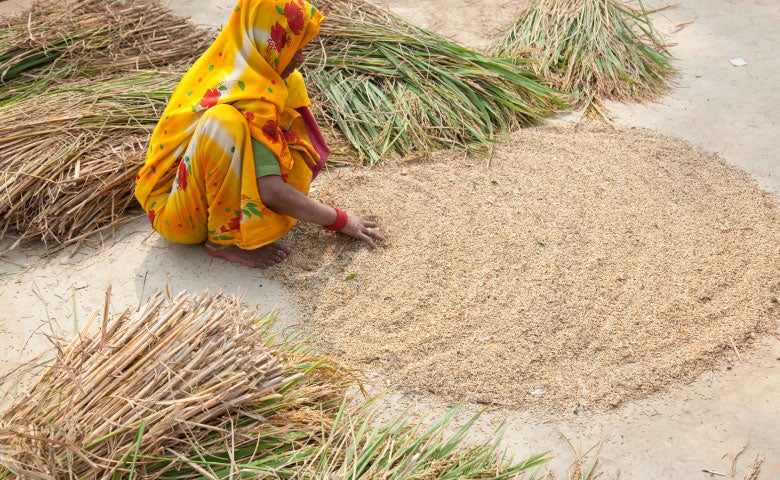
The foundation’s grantees help smallholder farmers like Kamlavati Devi of Mohanjot, India, grow more food and earn more money.
In the United States, our top mission is to help public schools ensure that all students can get ahead—especially those who typically face the greatest barriers, including Black and Latino students, and children from low-income backgrounds. We do this from the K-12 level through college. The progress in education is less dramatic than in health—there is no vaccine to improve the school system—but we have an excellent team and partners who are continually learning and improving. In the next section, I’ll describe how we refined our K-12 strategy this year.
One significant change this year is that we expanded our board of trustees. It now has eight members, including Melinda, foundation CEO Mark Suzman, and me, as well as five talented and experienced women and men who aren’t otherwise connected to the foundation. Mark will have a lot to say about activities at the foundation, including our board, in his annual letter on the foundation’s website next month.
Some people have asked: Why create a foundation in the first place? Would it have been better to donate the money directly to existing groups? Donors have to make their own decisions about this, and there’s no wrong answer.
“Why create a foundation in the first place?”
Personally, when I thought about how I could do the most good for the most people, the answer was to use my resources to direct more of the world’s funding and innovative IQ toward reducing inequity. And the most effective way to do that was to build a new organization with people from the public and private sectors who know how to get new tools invented and delivered. There weren’t any existing groups with this focus and mix of talent. But this model has worked phenomenally well in the private sector, and I believed it could work in the nonprofit sector too.
Two decades in, I still feel that way. Eventually the foundation will spend all its money and shut its doors. When it does, its most important contribution will not be the billions of dollars given away; it will be the teams of experts who developed strategies, partnerships, and innovations to reduce inequity.

In the U.S., we’re doubling down on math.
Our work on education goes back to the foundation’s earliest days, and our focus on improving math skills goes back almost as far. Although there are many factors that affect a student’s trajectory, the evidence shows that it’s extremely important for them to succeed in math. For example, those who pass Algebra I by ninth grade are twice as likely to graduate from high school and more likely to go on to college, get a bachelor’s degree, and go on to a high-paying career. And those who don’t complete Algebra I have just a one-in-five chance of graduating from high school.
The explanations we’ve heard from teachers, students, and other experts may sound similar to your own experiences in school. It’s hard for students to see how math relates to the rest of their lives. They tune out if they fall behind the rest of the class, or they get bored if they’re far ahead of the class or if the subject doesn’t spark their interest. Teachers tell us repeatedly that their students find the math curriculum dull and irrelevant.
And now the pandemic has made America’s math problem even more urgent. Two months ago, the United States released a report card on the nation’s schools—officially known as the National Assessment of Educational Progress—and the news was grim. Scores in reading and math were down across the board, and the math results were especially worrisome. Just 26% of eighth graders were proficient in math, down 9 percentage points from 2019. These are the lowest numbers in nearly two decades.
The foundation’s education team was working on a new math strategy well before the latest NAEP numbers came out. They got input from educators, students, parents, researchers, and other experts. We announced the result of this work in October: We’re more than doubling the percentage of our K-12 funding that’s spent on math, from 40% to over 80%. Our funding will help develop better instructional materials that keep students interested and motivated, give teachers the support they need to deliver these materials, and make sure that each math course gets students prepared for the next one.
In class and at home, students should be able to use software that’s interactive and personalized. It should know when they’re stuck and notify the teacher that they need extra help. Teachers should be able to choose from various ways of organizing students to help each other, for example helping them identify the students who are ahead and can help out the ones who are behind. The idea is to make the most of the teacher’s time and skills. We have many capable partners; the nonprofits Khan Academy and Zearn and the startup company Mastory, for example, are doing promising work.

This teacher and students are working on math at Brooklyn Lab Charter School in New York City. The foundation just announced a new education strategy with a major focus on math.
Now, we have to be humble about our efforts. As I’ve learned through the foundation’s work in this field, it’s one thing to make modest improvements in a few classrooms, and another thing to spark big improvements at scale. If we’re lucky, we’ll hit some of our milestones within three years and be able to prove out these new tools within five. That will set the stage for school districts and states to make sure that all students have well-supported teachers and an engaging curriculum that makes math feel relevant to their lives.

The world is a little more prepared for the next pandemic.
I’m loosely following the World Cup as I work on this letter, and as usual, soccer fans have been treated to some incredible games. But did you notice how much it looks like the pre-pandemic days? Globally, the numbers of infections and deaths are low enough that more office workers are on site at least some of the time, people are wearing masks much less often, and major public events are back.
It's fantastic that we’re out of the acute phase of the pandemic. But I’m concerned that we’ll forget how horrible it was, and that in our complacency we won’t push ahead with the things needed to prevent another pandemic—one that could be even worse. If I were to grade the world on its pandemic-prevention efforts so far, I’d give it an I for Incomplete.
It’s great that governments are putting more money into pandemic-related research. This money will speed up work on some crucial innovations, such as cheap and fast diagnostic tests that can be manufactured very quickly and vaccines that give you total immunity against all possible variants of a disease. (Today’s COVID vaccines just reduce the odds that you’ll get sick or die from specific variants.) But even more funding is necessary to accelerate the work—these are hard scientific puzzles to solve, and every moment matters in this race against microbes.
One crucial new piece of a global pandemic-prevention system is slowly coming together. As I argued in the book I published this year, How to Prevent the Next Pandemic, the world needs a global network of experts whose full-time job is to help head off global outbreaks. It should be responsible for a wide range of activities including watching out for potential pandemics, raising the alarm when they emerge, and helping to contain them.
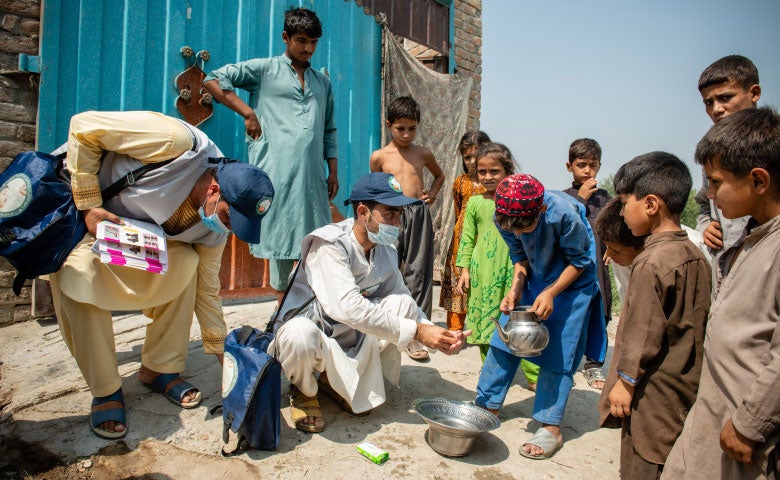
Programs like this COVID prevention campaign in Afghanistan’s Nangarhar Province are part of avoiding another devastating pandemic.
The World Health Organization is leading an effort to build such a network, with support from the health team at the Gates Foundation and other experts from around the world. They’ve drafted a preliminary paper outlining how it might work and are now refining it with health experts and national leaders. I hope this Global Health Emergency Corps, as they’re calling it, will be tested in a demonstration phase next year and become fully functioning by 2024. I wish it could happen faster, but I also understand that setting up a new global organization like this takes time, planning, and funding.
If you want to know more about pandemic prevention, you may want to check out my book, or wait for the paperback to come out next summer.

Polio eradication took a step backwards, but we can recover lost ground.
I’ve written in previous letters (such as this one) about how close the world is to eradicating polio, and what a magical moment in history it will be when we do. Unfortunately, COVID, extreme weather, and war have made it much harder for vaccinators to do their jobs.
Between 2019 and 2021, coverage for all childhood vaccines, including the one for polio, dropped by the biggest margin in almost three decades, and not surprisingly, polio started coming back. In 2021, it paralyzed just six children in the entire world; this year, 30 children were paralyzed as of December 6. In Pakistan alone, 20 children have been paralyzed, up from just one last year.

After several years of being limited to Afghanistan and Pakistan, wild poliovirus traveled to two countries in Africa this year. And strains of a variant polio virus were found in the sewers of London and New York. In each of these places, governments had to launch new efforts to stop the disease.
There could not be a better reminder that polio anywhere is a threat everywhere, and that we need to eradicate it. Of course, saying something is necessary doesn’t mean that it’s possible. I’ve underestimated this disease before, and I’ve been naïve about how difficult eradication would be, so I have to acknowledge that it could fail. But I don’t think it will.

When New York State had the first U.S. case of polio in nearly a decade, New Yorkers had to get immunized. (Ed JONES / AFP)
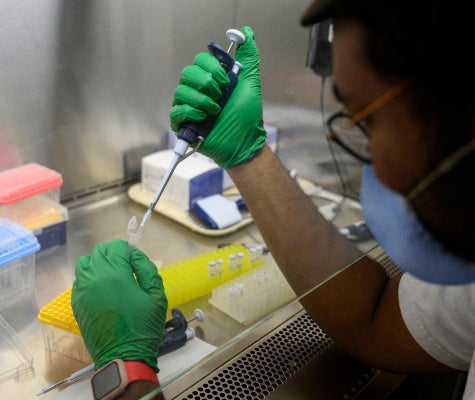
After the first polio case was detected in New York, the virus showed up in New York City’s sewage. (ANGELA WEISS/AFP)
When New York State had the first U.S. case of polio in nearly a decade, New Yorkers had to get immunized. (Ed JONES / AFP)
After the first polio case was detected in New York, the virus showed up in New York City’s sewage. (ANGELA WEISS/AFP)
Earlier this year, ten eminent scientists and health experts made the case for both why this disease should be eradicated, and why it can be eradicated, in the 2022 Scientific Declaration on Polio. This declaration is supported by more than 3,000 signatories from 117 countries. It’s short (much shorter than this letter), to the point, and well worth your time.
Here are my own reasons for being optimistic. Despite this recent comeback, the momentum is still on our side: Polio cases are down 99.9% over the past three decades. We now have a new vaccine, called nOPV2, that will prevent outbreaks of polio variants. As of November, more than 500 million doses of nOPV2 had been administered in 23 countries. And a more detailed look at the situation in Pakistan and Afghanistan shows that while cases were up slightly this year, the overall trend is that entire families of wild poliovirus are being eliminated.
We’re also learning from the recent setbacks. In October, the group leading the eradication effort—the Global Polio Eradication Initiative—adopted a smart five-year strategy for overcoming the final obstacles to eradication. And donors stepped up to partially fund this new strategy. In October the foundation announced a new $1.2 billion pledge, and pledges from other donors brought the total to $2.6 billion. There’s still a long way to go—the commitments amount to a little more than half of what GPEI needs to finish the job—but this was a fantastic start.
No update on polio would be complete without a big thank-you to Rotary International. They were part of this effort long before the Gates Foundation was. Since we became partners on eradication, we’ve jointly raised $1.8 billion for this work, and there’s more to come. Rotarians also lead massive vaccination campaigns to reach children all over the world. Sometime in the next few years, when polio is finally eradicated, my first phone call will be to thank and congratulate the team at Rotary International.

AI-powered ultrasounds could help save mothers and their babies.
A few weeks ago, we finished the latest round of strategy reviews at the foundation. This is when the leadership hears from various teams about what’s going well, what isn’t, and how they’re adjusting their strategies based on what they’ve learned. I get long documents filled with information to digest before each review. It’s one of my favorite times of the year at work.
Among the meetings that left me feeling especially optimistic was the one with our Maternal, Newborn, and Child Health Discovery and Tools team. As the name implies, they fund work on new tools that can save mothers and children in low- and middle-income countries. I want to tell you about two very cool innovations they’re supporting, but first I should give you the context for their work.
As you may remember from the chart of childhood deaths earlier in this letter, childhood deaths have fallen by half since 2000. But within this progress, there’s a tragically persistent problem: The number of babies who die in the first 30 days of life—what’s known as the neonatal period—is not dropping nearly as fast. Almost 1.9 million newborns died in 2019, only a third fewer than in 2000.
The causes of neonatal deaths are complicated. A death is often the result of several factors that leave the baby especially vulnerable. So to make a dent in newborn mortality, health workers need to deal with these underlying causes as early in the child’s life as possible, or even before they’re born.
The first step is to identify the women with the greatest risk of complications during pregnancy. In rich countries like the United States, we do this with frequent checkups, lab tests, and an ultrasound. Using images from this scan, health care workers can determine the health of the fetus and placenta, the gestational age and position, and so on.
But in low-income settings, ultrasound machines simply aren’t practical. They’re bulky and expensive. It takes special training to operate them, as you know if you’ve ever watched a technician painstakingly move the probe around an expectant mom’s belly and mark points on the computer screen. Then the images need to be read by a radiologist or other expert, people who are in short supply in developing countries.
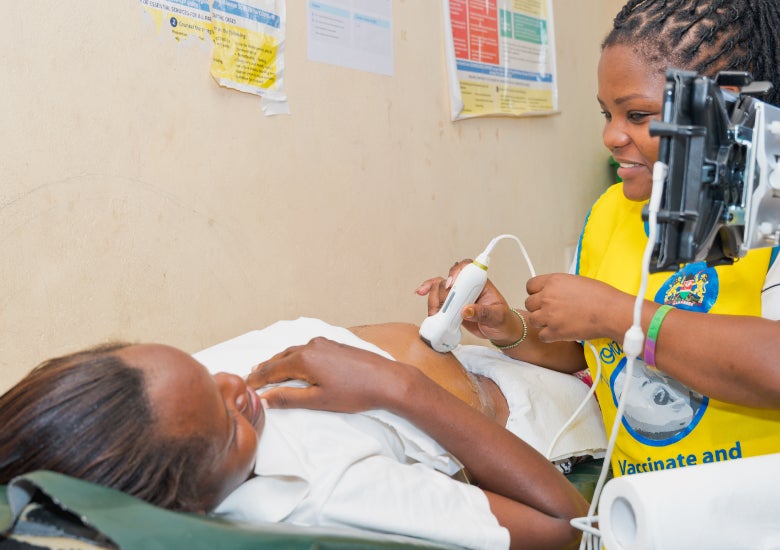
New ultrasound devices, like this one being used by a midwife in Kenya, don’t require massive equipment or training—they’re plugged into a mobile device and powered by AI.
The foundation and several partners are funding work that will vastly simplify the whole ultrasound process. Instead of wheeling in a big machine on a cart, you just plug a probe into a mobile phone or tablet. You swipe it across the mom’s belly a few times, and then up and down. Software uses artificial intelligence to read the images and provide all the information that a trained human would provide.
It’s a super-promising new approach. Studies have already shown that it accurately identifies high-risk pregnancies and is actually better than humans at estimating gestational age. Now it’s being tested in Kenya and South Africa to see whether using it at scale makes a measurable difference for moms and babies. If it does, we’ll bring in more partners to reduce the cost so that more countries can afford it.
By the way, this use of AI is just one example of the positive impact that artificial intelligence can have. Over the next few years, people are going to see the incredible progress in AI. I’m committed to making sure that these advances benefit everyone, and not just people in rich countries—for example, by using AI to help with developing new drugs, diagnosing diseases, and supporting students and teachers, in addition to identifying high-risk pregnancies in the way I’ve just described.
Of course, using AI to find expectant moms who might need extra medical care is only part of the solution. You also need interventions to treat them. Fortunately, there’s great progress on this front too. The story begins with a smart observation by, of all people, a group of eye doctors.
In the mid-2000s, a team of ophthalmologists from around the world was making trips to rural Ethiopia to help contain outbreaks of trachoma, a bacterial disease that causes blindness. In one community after another, kids would line up for banana-flavored doses of the antibiotic azithromycin to knock out the trachoma.
“The foundation and several partners are funding work that will vastly simplify the whole ultrasound process.”
Soon the doctors noticed something intriguing: The communities where children got the azithromycin seemed to have lower rates of child mortality than those where they didn’t.
To find out whether that was really true—and if so, why it was true—the foundation funded a large study involving about 200,000 children in three countries. When the results came out in 2018, we were thrilled. In places with high rates of child mortality, giving azithromycin preemptively to all children significantly improved the odds that they would survive.
Why would that be? Recently, researchers have been focusing on the idea that many birth problems start long before the baby is born and are connected to conditions in the mother’s digestive tract—especially an unhealthy gut microbiome. If the mom doesn’t have a good mix of bacteria, viruses, and other microbes, then her gut gets inflamed and can’t absorb all the nutrients she needs to stay healthy. Her baby will have the same problems, leading to malnutrition and possibly death.
The study we were so excited about revealed that the azithromycin was killing off bad bacteria in the children’s guts, reducing the inflammation and allowing their bodies to absorb essential nutrients. Based on this finding, local groups are now providing azithromycin to children under the age of one in Mali, Niger, and Nigeria, where child mortality rates are especially high. (For more on this fascinating story, see this blog post on the foundation’s site.)
After that study was finished, we turned to the next set of questions: Is it possible to reach kids earlier, before they’re born? Would it help both the baby and the mom to treat her while she’s in labor? What about before she goes into labor, in the second and third trimesters? Two studies involving tens of thousands of women in Africa and South Asia just concluded this year. The findings haven’t been published yet, but I’m optimistic that they’ll show significant gains for mothers and babies.

The foundation’s grantees are working to make sure that newborns, like this one in Vellore, India, are able to survive and thrive.
Yet even then, this work won’t be finished. We still need to find the optimal ways to deliver these interventions along with other foods specially formulated to help pregnant women stay healthy. They’ll need to be affordable and tailored to local tastes. Ultimately, our goal is to help health workers identify high-risk pregnancies with inexpensive, easy-to-use ultrasounds and then treat the moms with safe, cheap interventions that will keep them healthy and give their babies a strong start in life.

Gene therapy could cure AIDS.
If there’s one subject I’ve written about as often as polio in my previous letters, it’s probably HIV/AIDS. With polio, the story is how close we are to the finish line. With HIV, the story has been how far away we are. Even though there has been incredible progress in providing treatment to people with HIV and good progress on reducing its spread, a cure for the disease has always seemed like wishful thinking.
That’s no longer true. Based on recent research, some of it supported by the foundation, I think there’s a good chance that a cure for HIV will be available in 10 to 15 years. Even sooner, we could have a cure for another major killer as well: sickle cell disease.
Both breakthroughs rely on gene therapy, which involves making edits to small portions of a person’s genetic makeup. These edited genes can’t be passed on to the person’s children, but they can fix genetic mutations that cause the patient debilitating and deadly medical problems.
In the case of sickle cell disease, the idea is to repair a genetic mutation that causes a person’s red blood cells to be curved, like a farmer’s sickle, rather than round. This misshaping effect keeps the cells from carrying oxygen effectively. In people who inherit the trait from both parents, all of the red blood cells have the sickle shape, which causes episodes of awful pain, damages their internal organs, and usually leads to an early death.
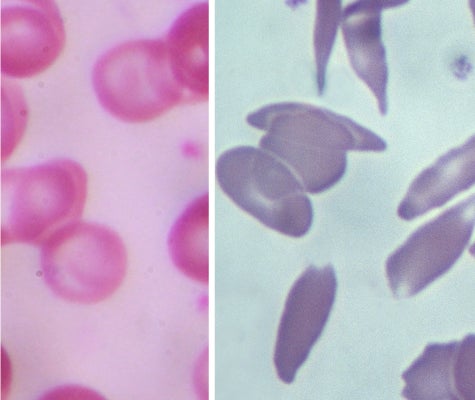
The photo on the left shows healthy red blood cells, while the one on the right shows cells that are misshapen because of the sickle cell trait. (Getty Images).

Until there’s a cure, screening for HIV/AIDS will be a key part of dealing with the disease.
The photo on the left shows healthy red blood cells, while the one on the right shows cells that are misshapen because of the sickle cell trait. (Getty Images).
Until there’s a cure, screening for HIV/AIDS will be a key part of dealing with the disease.
But if most everyone who inherits the sickle cell trait from both parents dies young, why hasn’t the trait been eliminated by natural selection? Surprisingly, the answer has to do with the parasite that causes malaria.
When this parasite enters the red blood cells of someone who inherited the sickle cell trait from only one parent, the cells “sickle”—that is, they become misshapen. These sickled cells, and the malaria parasite within them, are then destroyed by the spleen. These people are much less likely to get sick and die of malaria, which is why the trait is still around, and why people from regions where malaria is highly prevalent—such as sub-Saharan Africa—are more likely to have it.
Gene therapy can be used to cure sickle cell disease today, but it’s a difficult and time-consuming process; it involves removing the cells that create red blood cells, fixing their genetic code so their offspring are shaped right, and then returning them to your body. At $2.8 million per person, it’s prohibitively expensive even in the United States, not to mention in poor countries.
The work we’ve been funding is designed to make it far easier and cheaper. Our vision is that you could be cured with a single injection containing the equivalent of a microscopic car, which would navigate to the mother cell and deliver a passenger, which would get inside the cell and fix the mutated gene.
The idea sounds fanciful, but there was real progress on it just this year when a researcher at the University of Washington here in Seattle accomplished it in a monkey. We’re funding several dozen companies and academic labs to pursue different ways of designing the car and passenger. Many of their designs will fail, but from the ones that succeed, we’ll choose the most promising and fund research on whether they’re safe.
The beauty of this approach is that it should work for curing HIV too. With a single shot, your body will have new ways to fight off the virus and keep it from invading your cells.
Scientists are working on various ways to accomplish this. One approach is to modify the surface of the cells that HIV likes to invade, making it much harder for the virus to get inside them.
There are still years of work ahead before any of these approaches are proven safe and effective. The earliest versions might be short-lived and require additional doses to keep the HIV from coming back. And there’s the big question of how it can be made cheap enough: The foundation team thinks the treatment needs to cost on the order of $1,000 to $2,000 per person, a tiny fraction of the current $2.8 million price tag for sickle cell treatment. For every innovation the foundation supports, we also work on ways to make it affordable to people in poorer countries. Otherwise it won’t help reduce inequity, which is our ultimate goal.
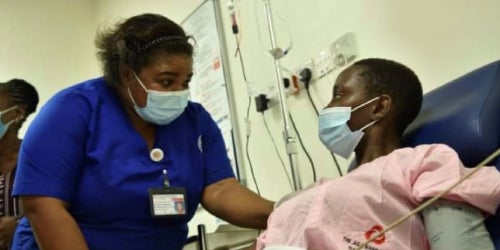
Gene therapy could one day cure sickle cell disease and make blood transfusions like this one, in Dar es Salaam, Tanzania, unnecessary.
It's hard to overstate the benefits of a cure for AIDS. Today, roughly 38 million people around the world are living with HIV, and another 1.5 million become newly infected each year. To survive, they have to take antiretroviral drugs every day for the rest of their lives. An ideal HIV cure will free all of them from taking these drugs and save the world millions of dollars a year in treatment costs. It will also mean that millions of people never have to worry about getting HIV in the future. Thanks to the advances in gene therapy, I’m now optimistic about the opportunity to end the AIDS pandemic.

Better buildings can help with climate change.
I can sum up the solution to climate change in two sentences: We need to eliminate global emissions of greenhouse gases by 2050. Extreme weather is already causing more suffering, and if we don’t get to net-zero emissions, our grandchildren will grow up in a world that is dramatically worse off.
I can sum up the challenge in two sentences: Getting to zero will be the hardest thing humans have ever done. We need to revolutionize the entire physical economy—how we make things, move around, produce electricity, grow food, and stay warm and cool—in less than three decades.

My journey into clean energy began with the Gates Foundation’s agriculture program. I set out to learn about the plight of smallholder farmers in the countries where we fund work, which led to learning about the problems they face as weather gets more extreme. That in turn led me to learn about climate change, and ultimately to the creation of Breakthrough Energy.
I should explain the differences between the foundation’s work on climate and BE’s work on clean energy, because they’re intentionally distinct from each other.

New types of crops, such as this rice, will help smallholder farmers adapt to a changing climate.

Millions of smallholder farmers like Jenny Zacharia of Mbuguni, Tanzania, rely on cassava as a staple crop.
New types of crops, such as this rice, will help smallholder farmers adapt to a changing climate.
Millions of smallholder farmers like Jenny Zacharia of Mbuguni, Tanzania, rely on cassava as a staple crop.
The foundation works on adaptation (the process of adjusting to the warming that’s already taking place). It starts from the idea that the poorest are suffering the most from climate change, but businesses don’t have a natural incentive to make tools that help them. A seed company can earn profits from, say, a new type of tomato that’s a nicer shade of red and doesn’t bruise easily, but it has no incentive to make better strains of cassava that (a) survive floods and droughts and (b) are cheap enough for the world’s low-income farmers. The foundation’s role is to make sure that the poorest benefit from the same innovative skills that benefit richer countries.
On the other hand, philanthropy alone can’t eliminate greenhouse gases. Only markets and governments can achieve that kind of pace and scale. The incentives are there to create new zero-carbon technologies—there’s a huge global demand for them—but companies need early investors and technical support to prove out their ideas. This is why Breakthrough Energy is separate from the foundation, and why its work includes investments in companies that hope to make a profit.
It may seem strange to talk about profit-making ventures in a letter about giving away my resources. There are two key points here. One is that any profits I make on BE investments will go either to the foundation or back into climate work. The other key point is that companies need to be profitable so they can grow, keep running, and prove that there’s a market for their products. The profit incentive will attract other innovators, creating competition that will drive down the prices of zero-emissions inventions and have a meaningful impact on emissions from buildings.
So how is the world doing on the march toward zero emissions? Unfortunately, on near-term goals, we’re falling short. Between 2021 and 2022, global emissions actually rose from 51 billion tons of carbon equivalents to 52 billion tons.
The good news is that we’re much further along than I would have predicted a few years ago on getting companies to invest in zero-carbon breakthroughs.
“We’re much further along than I would have predicted a few years ago on getting companies to invest in zero-carbon breakthroughs.”
Public funding for climate-related research and development has increased by almost a third since the Paris climate summit in 2015. This year, the U.S. adopted climate-related laws that together provide more than $500 billion for the energy transition. This money will unlock far more in private investments and spur hundreds of new clean-energy projects.
Private funding for clean energy is also increasing dramatically. In the past two years, venture capital firms have put approximately $70 billion into clean-energy startups. The climate-focused investment fund I helped launch, Breakthrough Energy Ventures, now has more than 100 companies in its portfolio.
In October, we gathered these companies at a conference in Seattle hosted by Breakthrough Energy. Just before the event, I got updates from two that have ingenious solutions to a mundane-sounding but important problem: heat leakage.
Buildings are a surprisingly large source of emissions. The energy they use for air conditioning, heating, lights, and so on is responsible for nearly 14% of all greenhouse gases. And buildings waste a lot of energy: Because of inefficient windows and gaps in what’s known as the building envelope, as much as 40% of heated or cooled air leaks out of the typical building.
Luxwall, a company based in Michigan, has developed an incredibly efficient next-generation window. It consists of two specially coated glass panes with a vacuum between them, much as a Thermos bottle is made with two layers. It’s roughly as efficient as fiberglass insulation and many times more efficient than the single-pane windows used in most buildings. Luxwall recently began shipping their products to a few pilot projects in the U.S., and they’re planning to start construction on a large manufacturing facility early next year.

Aeroseal’s approach to sealing leaky ducts and building envelopes has already been used in hundreds of thousands of buildings.
Another example is Aeroseal, an Ohio-based company that deals with all the air leakage not involving windows. They’ve developed a polymer that’s light enough to float in the air. To seal up a building, they close all the doors and windows, blow air into the building to raise the pressure inside, and then release a fog of these polymers. As the air heads for leaky spots in the air ducts and walls, it carries the polymers, and they build up in the cracks and crevices, making them air-tight. Thanks to deals with several large homebuilders and developers in the United States and Canada, Aeroseal has already sealed 250,000 buildings. Within three years, they hope to be doing that many every year.

Thinking about what matters as we head into 2023.
With the pandemic, war in Ukraine, and downturn in the economy, the past three years have been some of the hardest in recent memory. Everyone in the world has experienced loss during this time—of loved ones, financial security, or a way of life. Because of my position, I’m insulated from many of these hardships. But I too have hit some personal low points over the past few years, including the death of my father and the end of my marriage.
As I reflect on the past and look ahead to next year, I’m feeling grateful for the people in my life who support me in difficult moments. They remind me of what’s important, and they inspire me to be a better father and friend. Being wealthy makes my life much more comfortable, but not more fulfilling. For that, I need family, friends, and a job where I work on things that matter. I’m grateful to have all three.
One of the joys of getting older is to see my three children welcome wonderful new people into our family. Last year I gained a son-in-law, and next year I’ll become a grandfather. I hope I can be as good with my grandchildren as my dad was with his.
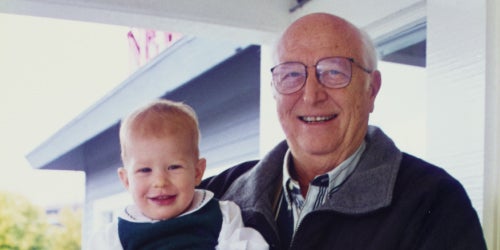
My dad and my daughter Jennifer in 1997.
I also hope that, through my work, I can help make the better world that future generations deserve. I am in awe of the caliber of people who have dedicated their lives to making the world a more equitable place, and I feel lucky to be able to support their efforts. My goal of keeping the world’s attention and resources on the poorest people is only possible because of their commitment.
The opportunities to reduce inequity, even at this tumultuous moment, are out there. Success is a long-term prospect, but it starts with actions we take now. I’ll spend 2023 trying to make the most of these opportunities, and whenever I get the chance, I will urge others to do the same.
I hope you have a happy end to 2022 and a healthy and peaceful 2023.





